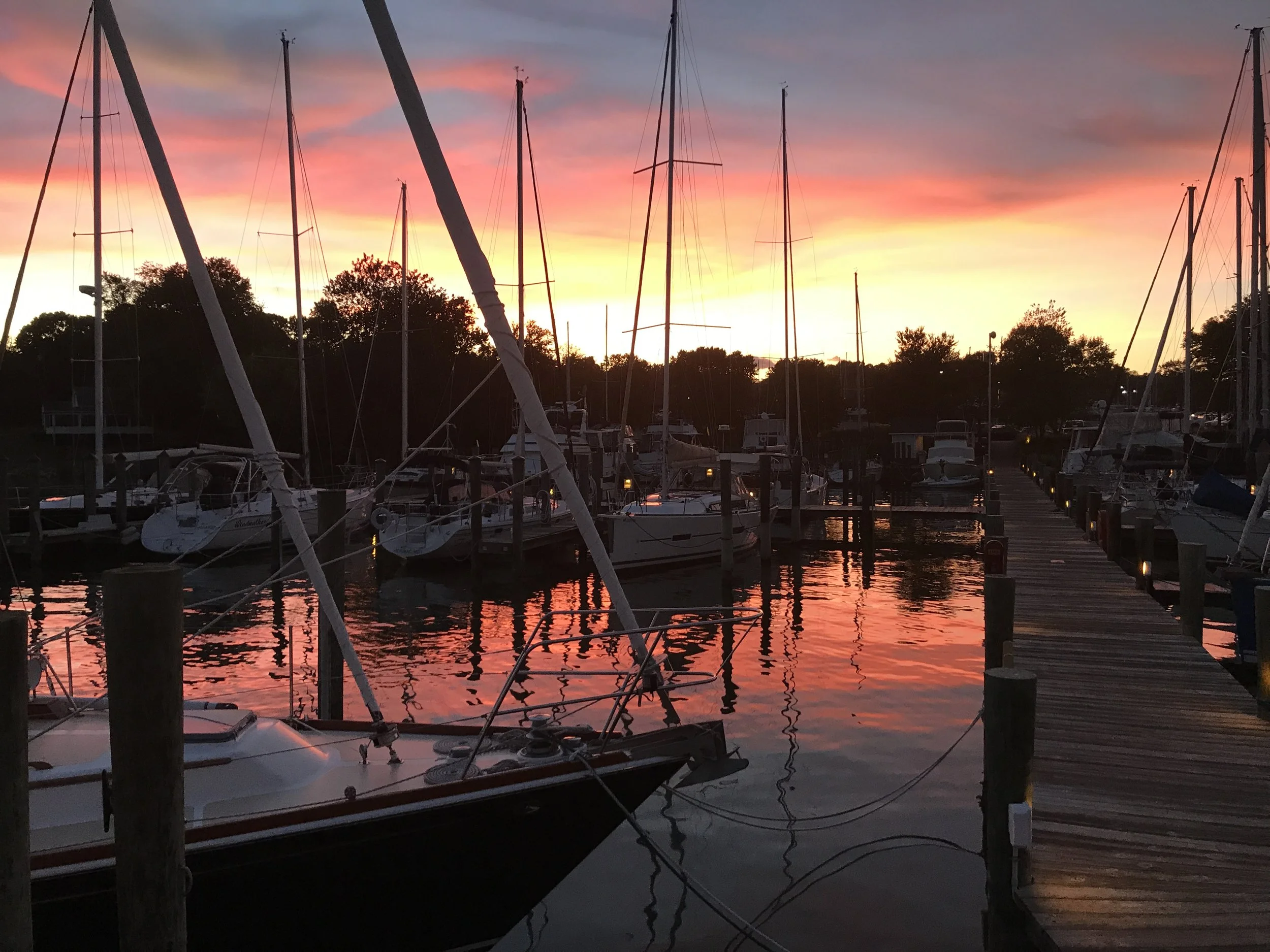what's it really going to cost you to be a liveaboard.
This is probably something we should've explored a bit more before jumping in to being a liveaboard. Really, for being a boat owner in general. Que sira. The long and the short of it is that the cost for us is roughly equivalent to a nice two bedroom apartment in Washington, DC. What can throw you is that its not paid out evenly like a house or apartment. In the following, I'll try to prepare you as best as I can and remove some of the surprise bills.
Below is an outline of expenses that will have a payment schedule.
- Boat Payment, this will be monthly and your largest expense. The only way to avoid these is to purchase your boat outright.
- Slip fee, Most marinas lease their slips on a yearly basis. The slip charge will be calculated by the length of the slip, not by the length of your boat. When calling around for slip pricing, they'll usually tell you a by the foot charge per month and give you lengths of available slips. Payment will typically be in bulk for the year. Most marinas will charge at the beginning of the season (Aprilish) and split the payment into two or three lumps over the next following months. Going month to month is possible but usually you'll be subletting someone else's slip lease. This would be handled by the marina. In some states its also possible to buy a slip outright. This is more ideal for a local resident than a liveaboard but its a possibility if you're interested. I can imagine that doing so would bring the addition of maintenance or marina fees.
- Liveaboard Fee, not something all marinas charge for but the ones that openly welcome liveaboards typically do. They say it's because you use more of the facilities.
- Insurance, A must have. The bank and/or the marina will require a minimum coverage level to protect themselves from damages. BoatUS used to be the go to for marine insurance but they're out of the game now and Geico underwrites their policies under the old banner. Insurance can be paid monthly or one lump sum starting on the anniversary of the day the policy was enacted.
- Electric, Some slips will include this but usually your slip is going to have its own meter. This is a monthly bill thats going to be based on usuage. Expect higher bills in the summer and in winter if you're using electric to heat your boat.
- Cable/Internet, Free wifi is becoming the norm at marinas. I'd recommend that you take advantage of this by installing a HD antenna and subscribing to streaming services. Cable is a possibility but why bother given the alternative. Not to worry, if there's something that you absolutely must watch, the marina's common area will have a tv with all the bells and whistles.
- Water, in most cases it is included in your slip fee.
There is the option to avoid marina and the above associated fees by anchoring out or hooking up to a mooring ball. But, this comes with a whole other set of issues that will be hard to go into here. It can be done and for less money but it's not a choice I would make unless I was forced too. It's more of an option for southern climates and individuals smart enough not to have a day job. I will address "living on the hook" as a stand alone article.
- Pump out service, Your poop has got to go somewhere and overboard is not an option. Most marinas will have a little boat that will swing by on a schedule and pump you out for a fee. You can scimp on this if you like. The alternative is either to regularly untie and cruise to the pump out dock or the other is to only use the marina bathroom. I can tell you that getting underway to go pump out will require locating a deck hand or two, repetitively not warming your engines up all the way won't be good for them, and doing this will become a massive hassle after a long day at work. Walking to the marina bathroom can be one also. Especially, in the middle of the night or in a driving rain storm. That's one of the reasons I suggest a 50 plus gallon waste tank as a prerequisite when finding a boat. The bigger the less attention it'll require.
- Rental storage, this also is optional. After you giveaway and/or sell all your home goods to do this thing, you're going to be left with items of sentimental value that won't fit on your boat. If you're lucky, you'll be able to store these at a friend or family member's house. If that's not in the cards however, a storage rental might be your only option. I thought we could get it all on board but there were things I didn't think about like my wife's wedding dress, picture albums, Christmas decorations with sentimental value and a lifetime collection of tools. Luckily, we were able to get a 5x5 storage rental close by.
- Laundry, You might be fortunate enough to have a washer/dryer on board but most boat/RV units are no where as powerful or as large as a home unit. Which leaves you with a couple of choices. The marina coin laundry(one or two machines, plus working loads around your slip mates), a local coin laundry (faster, more machines, but you have to stay there while the wash runs), or what we do, wash and fold service. You're charged by the pound for this service. It may sound extravagant but we found that its only about $20 more than doing it ourselves. More importantly, we recover the time it would take to do it and time is the only thing money can't buy back.
- Fuel, Some boats have propane or diesel powered appliances. Air heaters, stoves, grills, refrigeration, and/or hot water heaters can be wonderful devices and save you a ton of money on electricity during the winter or when anchoring out. To keep them going you'll need to fill containers or your tanks. If your iced in this means dragging this down the dock to fill up.
The next bit is the expenses that won't have a schedule but you will need to plan for.
- Short haul outs or diver services aka bottom cleaning, Depending on where you're located, all the little critters that live in the water around you are looking for shelter to one degree or another, and the bottom of your boat is prime real estate. The bottom paint (anti fouling) doesn't stop them from grabbing a spot. What it does is cause them to fall off when you're underway. If you're planning on living aboard and not traveling, you'll find that taking her out will be an event that you will need to prep for. All the stuff you place around the boat for day to day living will need to be stowed before heading out. This will effect how much you go out like it or not. Before you know it, the yard that is growing under your boat will need to be cut by a professional. Letting this go can give time for critters like barnacles to send tendrils into the boats gel coat causing expensive damage. In addition to this biological war going on under the water line is another potential front. Electrolysis; boats near yours and/or bad dock wiring might be leaching electrical current into the water. This stray current is minute. Usually 12 volt at extremely low amperage. Through electrolysis it can steal material from your metal boat parts that are under the water if not they're not protected. Protection comes in the form of sacrificial zincs that are attached to these metal parts. The stray current will eat up the zinc because it's less noble than the other metals. The zincs have a limited live span and will require replacement. The lifespan will depend upon your marina's conditions and requires constant monitoring. The cure for both of these problems is simple but can be costly. Your first choice and the most thorough is to hire a boat yard to haul the boat out to clean the bottom with pressure washers and replace the worn out zincs. Second, but not always permitted in the marina is hiring a diver service to go under the boat to scrub the hull and replace the zincs. Divers are less expensive but they won't be able to do the same level of cleaning. You also won't be able to make an assessment of the hull condition when using a diver. Diver cleaning services are banned in some marinas because they're not very good for the local ecology plus it drives business to the boat yard. Plan on this cleaning expense once every other year. Below is a picture of the growth we built up over the winter of 2016. Those critters can move in quick. In retrospect, it wouldn't have been so bad if we went out for a quick run before hauling out.
- Winter expenses; This applies to those of us in areas that freeze during the winter. Two things will come that you'll need to deal with. Luckily, they're a one shot payment. First, is a de-icer or "bubbler". With a thermostat you're looking at about $600. This will keep the ice from forming around your hull. Second is slip location and marina layout dependent, lengths of hose. When the freeze comes the marina will turn off the dock water but will have a frost free hose bib at the end of the pier. You'll have to run a hose to fill your tanks to have access to water on board. This can be pretty far away in some cases. For example, we own 475' of hose to make it to our slip from the hose bib. Good drinking water safe hose will cost about $70 per hundred feet. Some people recommend shrink wrapping for the winter. It will depend on your boat's set up to see if this is worth the expense. We have two diesel burning forced air heaters on board and wrapping our boat doesn't help as much as you think it would because of the large sliding glass door. The extra fuel we burn keeping things warm is less than the cost of wrapping her up.
- Bottom painting; One of your larger bills will be hauling out to repaint the bottom. This needs be be done every other year (depending upon local conditions). Alternating off years of your short hauls or diver service. This is an absolute must and will be just like your short haul but instead of going back into the water, you'll end up on land in the boatyard. You can plan on being homeless for at least two weeks. It's only 2 days worth of work but if you try to do it in one week it'll rain all that week guaranteed. I recommend checking out local Airbnb's for affordable short term renting. Some yards will allow you to stay on the boat but only unofficially. Allowing this is a liability and they most likely won't let you if they don't know you. Plus, you don't want to be subjected to all the work that's going on. During your time on land, you'll need to have the bottom sanded down and repainted. It will cost more but I highly recommend you get two coats. Just in case you have to stretch out the next time you do this. It'll be a good time to replace your zincs, inspect thru hulls and running gear for needed repairs or fix any blisters that may have popped up. It can also be a good time to buff and wax the sides of the hull, change the color of the bottom paint for a different look, add accessories like transom lights or new sonar sensors, or fix any dings in the gelcoat.
- Engines and transmission maintenance. These guys need attention too. Whether it's oil or fuel filter changes, winterizing or fixing a break down. They're always going to need something. Doing the basic maintenance is something you should take the time to learn to do for yourself. Not only is it good seamanship to know your engines but paying for an oil and filter change can run up into the $400 range on two diesel engines just for parts alone. Paying a maintenance service to come out can run to $1000. Save those labor cost for when you need real mechanical diagnosis and repair. Changing an air filter only takes a screwdriver, a fuel filter swap only needs a pair of gloves and a bucket, and checking your oil level and condition only takes a paper towel. Don't ignore the monsters below deck. It's always best when they're happy. Feed them with good fuel, oil and lots of attention.
- Boat cleaning and waxing; This is really a maintenance thing but worth talking about. Hosing your boat off isn't going to be good enough to keep her pretty. Washing and waxing are important. Not only for looks but to help keep the hull in good shape. Wax protects from UV damage, scuffing and most importantly fills in the microscopic holes in the gelcoat increasing it's life expectancy. If you pay to have this done, you're looking at $1000 to $4000 to machine buff a 40 foot boat depending upon the condition the finish is in. This is another craft I suggest you invest a little time in learning to save yourself lots of money.
Well, I hope I didn't scare you off. And sadly, I'm sure that I missed a couple things. Like I mentioned in the beginning, averaged out, these expenses are roughly the same as a nice two bedroom apartment in the city. It'll require more attention to details and good budgeting but it's completely worth it!
Cheers
Mike
Life's a Port


![IMG_0010[1].JPG](https://images.squarespace-cdn.com/content/v1/59c274973e00be59ca48a4c2/1507556985191-PRIP95GJO4N19SPFDYNQ/IMG_0010%5B1%5D.JPG)



